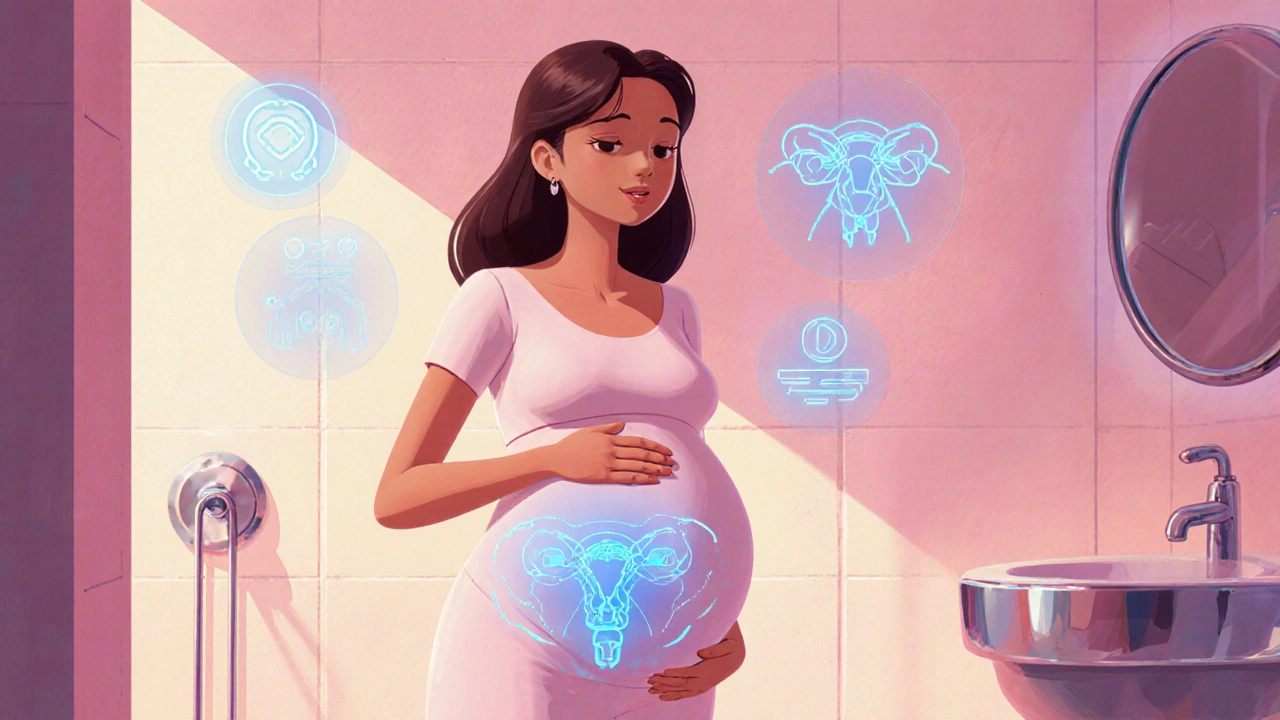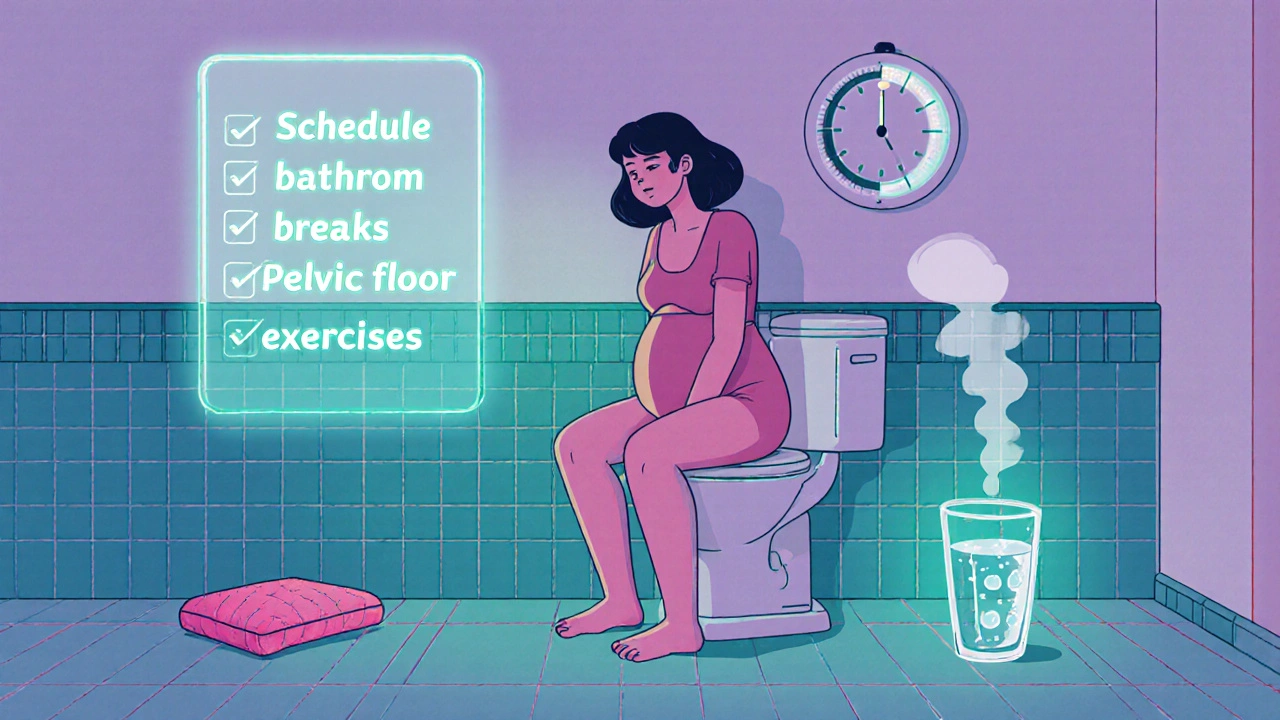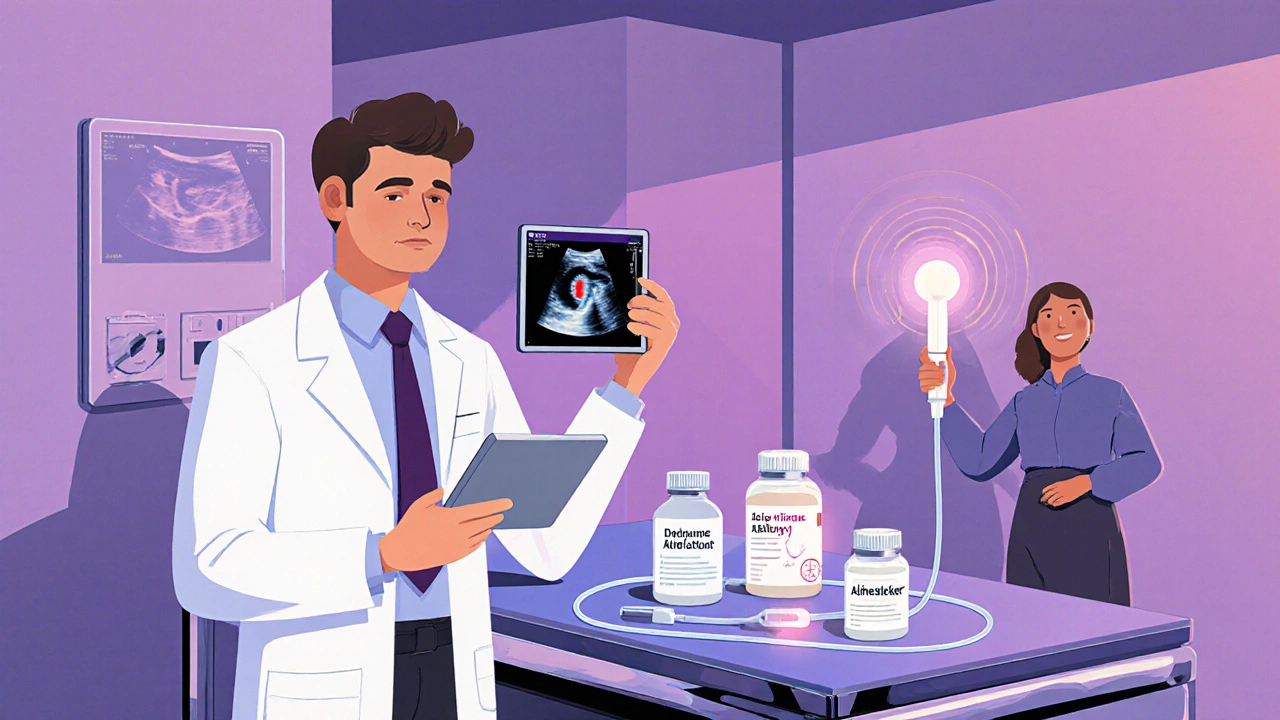How to Manage Difficulty Urinating During Pregnancy - Tips & Treatment
 Oct, 18 2025
Oct, 18 2025
Pregnancy Urination Symptom Checker
How Severe Are Your Symptoms?
Answer these questions to understand if you need immediate medical attention. Based on article guidelines.
Your Assessment Result
Important: This tool is for informational purposes only and does not replace professional medical advice. Always consult your obstetrician for personalized guidance.
Imagine being midway through your pregnancy and suddenly feeling like you can’t empty your bladder completely. It’s uncomfortable, it can be embarrassing, and it often leaves you wondering whether it’s a normal part of pregnancy or something that needs medical attention. This article walks you through the why, when, and how of handling difficulty urinating during pregnancy so you can stay comfortable and safe.
What Causes Difficulty Urinating in Pregnancy?
First, let’s break down the main culprits. During pregnancy a woman’s body undergoes major hormonal and anatomical shifts that directly affect the urinary system.
- Progesterone is a hormone that relaxes smooth muscle throughout the body. It relaxes the bladder wall, making the bladder less contractile and slowing down urine flow.
- The growing uterus exerts pressure on the pelvic floor muscles and the muscles that support the bladder and bowel, limiting how fully the bladder can empty.
- Urinary tract infection (UTI) is a bacterial infection that inflames the urinary tract. Even a mild UTI can cause a burning sensation and a feeling of incomplete emptying.
- Increased blood volume and kidney filtration rates raise the amount of urine produced, meaning you’re going to the bathroom more often. The mismatch between production and emptying can feel like a blockage.
Understanding these factors helps you target the right solutions, whether they’re lifestyle tweaks or medical interventions.
When to Call Your Obstetrician
Not every case of slower urine flow needs a doctor, but certain signs mean you should schedule a prenatal visit right away.
- Sharp pain in the lower abdomen or back that doesn’t improve with movement.
- Fever, chills, or a burning sensation when you urinate - classic UTI red flags.
- Inability to pass any urine for more than six hours (possible acute urinary retention).
- Blood in the urine, which could indicate infection or kidney stones.
- Swelling of the hips, thighs, or lower abdomen that makes it hard to sit comfortably on the toilet.
Your obstetrician can run a simple urine test, check bladder volume with an ultrasound, and decide if a catheter or medication is needed.
Self‑Care Strategies You Can Try at Home
Before reaching for medical tools, many pregnant people find relief with practical daily habits.
- Stay hydrated-but spread it out. Aim for 8‑10 glasses of water a day. Sip slowly rather than gulping large amounts, which can overwhelm the bladder.
- Schedule bathroom breaks. Instead of waiting for the urge, set a timer to go every two to three hours. This reduces bladder stretching and helps train better emptying.
- Adopt a forward‑leaning position. When you sit on the toilet, lean slightly forward and place your feet flat on the floor. The angle helps the bladder contract more fully.
- Warm compress. A warm (not hot) towel on the lower abdomen for 5‑10 minutes can relax pelvic muscles and encourage urine flow.
- Pelvic floor exercises (Kegels). Gentle strengthening followed by relaxation improves muscle control. Do three sets of 10 squeezes, holding each for five seconds, then fully release.
- Avoid constipating foods. Fiber‑rich meals, plenty of fruits, vegetables, and whole grains keep stools soft, reducing pressure on the bladder.
- Limit caffeine and carbonated drinks. These can irritate the bladder and increase urgency.
Most of these steps can be combined into a daily routine that eases the pressure and improves bladder emptying.

Medical Options When Home Measures Aren’t Enough
If self‑care doesn’t bring relief, physicians have several evidence‑based tools.
| Intervention | Purpose | Typical Use | Possible Side Effects |
|---|---|---|---|
| Intermittent catheterization is a sterile tube used to drain urine when the bladder won’t empty on its own | Immediate relief of urinary retention | Severe retention, post‑UTI management | Urinary tract irritation, occasional infection |
| Alpha‑blocker medication | Relax urethral smooth muscle to improve flow | Chronic difficulty, prescribed after safety evaluation | Dizziness, drop in blood pressure |
| Physical therapy with a trained physical therapist specializing in pelvic health | Teach proper muscle coordination, reduce pelvic pressure | Persistent symptoms after 4‑6 weeks of self‑care | None when performed correctly |
| Antibiotics | Treat underlying urinary tract infection | Positive urine culture or classic UTI symptoms | Possible GI upset, rare allergic reaction |
These options are usually considered after a thorough exam, ultrasound, and urine analysis. Your obstetrician will weigh the benefits against any potential risk to the fetus.
Lifestyle Adjustments for Long‑Term Comfort
Even after the immediate issue resolves, certain habits can keep bladder problems at bay throughout the rest of your pregnancy.
- Maintain a healthy weight. Excess weight adds pressure on the bladder and pelvic floor.
- Practice good posture. Sitting straight reduces abdominal compression.
- Wear loose‑fitting clothing. Tight waistbands can squeeze the bladder.
- Regular prenatal check‑ups. Your prenatal visit offers a chance to catch emerging urinary issues early.
These tweaks are simple, but they reinforce the body’s natural ability to manage urine flow.

Quick Checklist Before You Call the Doctor
- Track how often you urinate and any pain or burning.
- Note if you’ve tried the hydration and positioning tips for at least three days.
- Check for fever, blood in urine, or inability to pass any urine.
- Gather a list of any over‑the‑counter supplements you’re taking.
- Prepare questions about catheter use, medication safety, and pelvic floor therapy.
If any red‑flag symptom appears, schedule a prenatal appointment right away.
Frequently Asked Questions
Why does my bladder feel full even after I’ve peed?
Hormonal relaxation of the bladder wall and pressure from the uterus can prevent the bladder from contracting fully, leaving a residual feeling of fullness.
Is it safe to use a catheter during pregnancy?
Yes, when a doctor recommends intermittent catheterization it is done with sterile technique and carries a low infection risk. It’s typically reserved for severe retention that can’t be relieved otherwise.
Can pelvic floor exercises make the problem worse?
If performed incorrectly they can tighten the muscles too much, increasing obstruction. Work with a pelvic‑floor physical therapist to learn proper technique.
Do antibiotics harm the baby?
Most antibiotics prescribed for UTIs (e.g., amoxicillin, nitrofurantoin) are considered safe in pregnancy. Your obstetrician will choose the one with the best safety profile.
Will the problem go away after I give birth?
For most people, bladder function returns to normal once the uterus shrinks and hormone levels drop. However, if you develop pelvic floor weakness, continued exercises postpartum are recommended.
Difficulty urinating isn’t something you have to endure in silence. By recognizing the causes, watching for warning signs, and applying a mix of home remedies and medical care, you can keep your pregnancy comfortable and your health on track.

Janet Morales
October 18, 2025 AT 17:41I can’t believe anyone would think that a simple bladder tweak is all it takes during pregnancy. The hormonal roller‑coaster alone turns the urinary system into a ticking time bomb. You’re not just sipping water and hoping for the best; you’re fighting a physiological siege. Progesterone relaxes the bladder so much that it becomes a lazy sack, refusing to contract. And let’s not forget the uterus, that relentless balloon, pressing down like a weight bench on your pelvis. If you ignore the fact that these forces can actually cause acute retention, you’re courting disaster. The article’s tip about leaning forward is cute, but it’s only a Band‑Aid on a cracked pipe. Real relief comes from monitoring bladder volume with an ultrasound, not just guessing. Only a qualified obstetrician can decide whether intermittent catheterization is warranted. Trusting a “schedule bathroom breaks” plan while the kidneys are pumping out 2‑3 liters a day is naive. You deserve more than “stay hydrated but spread it out” when your body is literally reshaping. Every missed stream adds pressure, and that pressure can cascade into infections, stones, or worse. Don’t be fooled by the calm tone of the guide; the stakes are high. If you ever feel a burning sensation, fever, or blood in the urine, call your doctor immediately-no waiting. And if the pain becomes sharp and unrelenting, you might be dealing with a hidden obstruction that needs imaging. Bottom line: treat difficulty urinating as a red flag, not a mild inconvenience, and demand proper medical evaluation.
Albert Fernàndez Chacón
October 30, 2025 AT 06:43Honestly, the tips in the article are pretty solid if you stick to them consistently. I’ve seen a lot of pregnant friends just sip water all day and end up with a constantly full bladder. Setting a timer every two to three hours helps train the bladder to empty more completely. Also, the forward‑leaning position is a simple mechanical trick-gravity does most of the work. If you still feel stuck after a few days, a quick check‑up can rule out an infection.
Drew Waggoner
November 10, 2025 AT 20:46What’s the point of sugar‑coating this whole “just lean forward” nonsense? You’re dealing with a hormone that literally turns your bladder into a lazy balloon, and the article pretends a cushion will fix it. I’ve watched women struggle for weeks, and the only thing that actually clears the backlog is proper medical assessment-not DIY posture hacks. If you’re in pain and can’t empty at all, you need a catheter, not a pep talk. Don’t settle for half‑measures while your body is screaming for help.
Mike Hamilton
November 22, 2025 AT 10:50i think its worth noting that the body during pregnancy is like a rolling stone, always shifting, and that shifting can press on the bladder in ways we dont often consider. the simple act of staying upright, not slouching, can reduce that pressure a bit. also, cultural practices like warm compresses have been used for ages, and there is some truth to them. just remember, no single trick is a cure‑all, and listening to your own signals is key.
Liberty Moneybomb
December 4, 2025 AT 00:53Oh great, another “just drink more water” memo from the medical establishment trying to keep us in the dark. They don’t want us to know that the real reason the uterus swells is because of hidden chemicals they pump into our food supply, and those same chemicals mess with our urinary tract. If you’re feeling that constant pressure, maybe it’s not just hormones-it could be a covert plot to keep pregnant women dependent on pharmaceuticals. Stay vigilant, question every “standard” recommendation, and never let a “friendly” doctor decide without a second opinion.
kendra mukhia
December 15, 2025 AT 14:56Listen, the whole “schedule bathroom breaks” advice is basic common sense, not rocket science. If you can’t follow a simple timer, you’re not giving yourself a chance to manage the issue. The article also fails to stress that pelvic floor dysfunction is often self‑inflicted by incorrect Kegel practices. Get a qualified pelvic‑floor therapist, learn the right technique, and stop blaming vague “hormones” for everything.